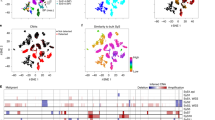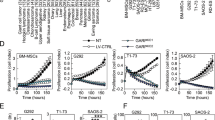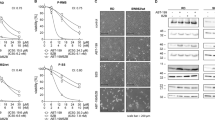Abstract
Synovial sarcoma is a deadly malignancy with limited sensitivity to traditional cytotoxic chemotherapy. SS18-SSX fusion oncogene expression characterizes human synovial sarcomas and drives oncogenesis in a mouse model. Elevated expression of BCL2 is considered a consistent feature of the synovial sarcoma expression profile. Our objective was to evaluate the expression of apoptotic pathway members in synovial sarcomas and interrogate the impact of modulating SS18-SSX expression on this pathway. We show in human and murine synovial sarcoma cells that SS18-SSX increases BCL2 expression, but represses other anti-apoptotic genes, including MCL1 and BCL2A1. This repression is achieved by directly suppressing expression via binding through activating transcription factor 2 (ATF2) to the cyclic adenosine monophosphate (AMP) response element (CRE) in the promoters of these genes and recruiting TLE1/Groucho. The suppression of these two anti-apoptotic pathways silences the typical routes by which other tumors evade BH3-domain peptidomimetic pharmacotherapy. We show that mouse and human synovial sarcoma cells are sensitive in vitro to ABT-263, a BH3-peptidomimetic, much more than the other tested cancer cell lines. ABT-263 also enhances the sensitivity of these cells to doxorubicin, a traditional cytotoxic chemotherapy used for synovial sarcoma. We also demonstrate the capacity of ABT-263 to stunt synovial sarcomagenesis in vivo in a genetic mouse model. These data recommend pursuit of BH3-peptidomimetic pharmacotherapy in human synovial sarcomas.
This is a preview of subscription content, access via your institution
Access options
Subscribe to this journal
Receive 50 print issues and online access
$259.00 per year
only $5.18 per issue
Buy this article
- Purchase on Springer Link
- Instant access to full article PDF
Prices may be subject to local taxes which are calculated during checkout




Similar content being viewed by others
References
Ladanyi M, Antonescu CR, Leung DH, Woodruff JM, Kawai A, Healey JH et al. Impact of SYT-SSX fusion type on the clinical behavior of synovial sarcoma: a multi-institutional retrospective study of 243 patients. Cancer Res 2002; 62: 135–140.
Haldar M, Hancock JD, Coffin CM, Lessnick SL, Capecchi MR . A conditional mouse model of synovial sarcoma: insights into a myogenic origin. Cancer Cell 2007; 11: 375–388.
Haldar M, Hedberg ML, Hockin MF, Capecchi MR . A CreER-based random induction strategy for modeling translocation-associated sarcomas in mice. Cancer Res 2009; 69: 3657–3664.
Su L, Sampaio AV, Jones KB, Pacheco M, Goytain A, Lin SC et al. Deconstruction of the SS18-SSX fusion oncoprotein complex: insights into disease etiology and therapeutics. Cancer Cell 2012; 21: 333–347.
Hirakawa N, Naka T, Yamamoto I, Fukuda T, Tsuneyoshi M . Overexpression of bcl-2 protein in synovial sarcoma: a comparative study of other soft tissue spindle cell sarcomas and an additional analysis by fluorescence in situ hybridization. Hum Pathol 1996; 27: 1060–1065.
Sun B, Sun Y, Wang J, Zhao X, Wang X, Hao X . Extent, relationship and prognostic significance of apoptosis and cell proliferation in synovial sarcoma. Eur J Cancer Prev 2006; 15: 258–265.
Knosel T, Heretsch S, Altendorf-Hofmann A, Richter P, Katenkamp K, Katenkamp D et al. TLE1 is a robust diagnostic biomarker for synovial sarcomas and correlates with t(X;18): analysis of 319 cases. Eur J Cancer 2010; 46: 1170–1176.
Mancuso T, Mezzelani A, Riva C, Fabbri A, Dal L, Sampietro Bo, G. et al. Analysis of SYT-SSX fusion transcripts and bcl-2 expression and phosphorylation status in synovial sarcoma. Lab Invest 2000; 80: 805–813.
Joyner DE, Albritton KH, Bastar JD, Randall RL . G3139 antisense oligonucleotide directed against antiapoptotic Bcl-2 enhances doxorubicin cytotoxicity in the FU-SY-1 synovial sarcoma cell line. J Orthop Res 2006; 24: 474–480.
Tse C, Shoemaker AR, Adickes J, Anderson MG, Chen J, Jin S et al. ABT-263: a potent and orally bioavailable Bcl-2 family inhibitor. Cancer Res 2008; 68: 3421–3428.
Wilson WH, O'Connor OA, Czuczman MS, LaCasce AS, Gerecitano JF, Leonard JP et al. Navitoclax, a targeted high-affinity inhibitor of BCL-2, in lymphoid malignancies: a phase 1 dose-escalation study of safety, pharmacokinetics, pharmacodynamics, and antitumour activity. Lancet Oncol 2010; 11: 1149–1159.
Gandhi L, Camidge DR, Ribeiro de Oliveira M, Bonomi P, Gandara D, Khaira D et al. Phase I study of Navitoclax (ABT-263), a novel Bcl-2 family inhibitor, in patients with small-cell lung cancer and other solid tumors. J Clin Oncol 2011; 29: 909–916.
Yecies D, Carlson NE, Deng J, Letai A . Acquired resistance to ABT-737 in lymphoma cells that up-regulate MCL-1 and BFL-1. Blood 2010; 115: 3304–3313.
Tahir SK, Wass J, Joseph MK, Devanarayan V, Hessler P, Zhang H et al. Identification of expression signatures predictive of sensitivity to the Bcl-2 family member inhibitor ABT-263 in small cell lung carcinoma and leukemia/lymphoma cell lines. Mol Cancer Ther 2010; 9: 545–557.
Li C, Wong WH . Model-based analysis of oligonucleotide arrays: expression index computation and outlier detection. Proc Natl Acad Sci USA 2001; 98: 31–36.
Nakayama R, Mitani S, Nakagawa T, Hasegawa T, Kawai A, Morioka H et al. Gene expression profiling of synovial sarcoma: distinct signature of poorly differentiated type. Am J Surg Pathol 2010; 34: 1599–1607.
Liu TM, Guo XM, Tan HS, Hui JH, Lim B, Lee EH . Zinc-finger protein 145, acting as an upstream regulator of SOX9, improves the differentiation potential of human mesenchymal stem cells for cartilage regeneration and repair. Arthritis Rheum 2011; 63: 2711–2720.
Nakayama R, Nemoto T, Takahashi H, Ohta T, Kawai A, Seki K et al. Gene expression analysis of soft tissue sarcomas: characterization and reclassification of malignant fibrous histiocytoma. Mod Pathol 2007; 20: 749–759.
Joshi SK, Hashimoto K, Koni PA . Induced DNA recombination by Cre recombinase protein transduction. Genesis 2002; 33: 48–54.
Su L, Cheng H, Sampaio AV, Nielsen TO, Underhill TM . EGR1 reactivation by histone deacetylase inhibitors promotes synovial sarcoma cell death through the PTEN tumor suppressor. Oncogene 2010; 29: 4352–4361.
Kawai A, Naito N, Yoshida A, Morimoto Y, Ouchida M, Shimizu K et al. Establishment and characterization of a biphasic synovial sarcoma cell line, SYO-1. Cancer Lett 2004; 204: 105–113.
Acknowledgements
We gratefully acknowledge the support of the Paul Nabil Bustany Fund for Synovial Sarcoma Research, the Huntsman Cancer Foundation, and career development support from National Cancer Institute (NIH) K08CA138764. This work was also supported by grants from the Canadian Cancer Society Research Institute (Grant no.018355) and the Terry Fox Foundation and CIHR Institute of Cancer (TFF 105265). We thank Matt Hockin, PhD, at the University of Utah for producing the TATCre protein.
Author information
Authors and Affiliations
Corresponding author
Ethics declarations
Competing interests
The authors declare no conflict of interest.
Additional information
Supplementary Information accompanies the paper on the Oncogene website
Supplementary information
Rights and permissions
About this article
Cite this article
Jones, K., Su, L., Jin, H. et al. SS18-SSX2 and the mitochondrial apoptosis pathway in mouse and human synovial sarcomas. Oncogene 32, 2365–2371 (2013). https://doi.org/10.1038/onc.2012.247
Received:
Revised:
Accepted:
Published:
Issue Date:
DOI: https://doi.org/10.1038/onc.2012.247
Keywords
This article is cited by
-
Synovial sarcoma with intra-abdominal metastasis causing hemoperitoneum: a case-report
World Journal of Surgical Oncology (2023)
-
Upregulation of ERK-EGR1-heparanase axis by HDAC inhibitors provides targets for rational therapeutic intervention in synovial sarcoma
Journal of Experimental & Clinical Cancer Research (2021)
-
Synovial Sarcoma: A Complex Disease with Multifaceted Signaling and Epigenetic Landscapes
Current Oncology Reports (2020)
-
Establishment and proteomic characterization of a novel synovial sarcoma cell line, NCC-SS2-C1
In Vitro Cellular & Developmental Biology - Animal (2018)
-
Synovial sarcoma is a gateway to the role of chromatin remodeling in cancer
Cancer and Metastasis Reviews (2015)



